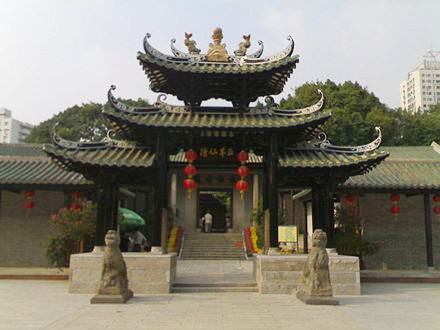You may have noticed that the eighth book I have written is a novel called Through the Five Genii Gate. Here is a current picture of the gate, properly called The Temple of the Five Immortals. It was erected during the Ming dynasty (c. 1377) as a Taoist temple in the Chinese city of Canton, now known as Guangzhou.

The Five Immortals refer to the five essential
elements that governed Chinese life: fire,
water, wood, metal, and earth.
Picture From Wikipedia Commons
My book is about a woman, Kathryn, who seeks a meaningful life by escaping from west Texas and going to China in 1913 by herself.Eventually, she finds work worth doing, marries, has children, experiences the death of her husband, and is commanded to leave China. Instead, she stays until the Japanese accelerate their pre-WWII incursions into China in 1937 by seizing coastal territory and Shanghai and making their way up the Yangtze. Kathryn and her daughters have traveled up the Yangtze, making it as far Chungking (now Chongqing) when they learn they must escape from China. Her son who was on the coast is missing, perhaps dead. Kathryn and her daughters endure hardships, uncertainty, and peril to escape from China, but eventually they make it to the United States where they hope to see Kathryn’s son.
When she arrived in China, full of hope in 1913, she was transported from the Pearl River to the center of Canton through the Five Genii Gate by a sedan chair hoisted by four coolies. When she departed China, full of despair in 1937, she and her daughters are transported in a sedan from the center of Canton to the Pearl River, which will take her to Hong Kong to board a ship to the United States.
My book is about hope. . .and I believe Writing the Five Genii Way is also about hope.
IF YOU’D LIKE TO KNOW MORE ABOUT THE BOOK:
The book has two narrative arcs. The main arc occurs in the five months between July and November 1937, when Kathryn and her daughters flee from the Japanese who are seizing parts of China as their prologue to WWII. When Kathryn and her daughters arrive on the Yangtze in Chungking, they learn of the invasion and understand they too must escape from China, entirely on their own (her husband has died, and her son goes missing in the first coastal skirmishes).
The second arc of the narrative occurs in the 36 years from 1901 to 1937. Despite her courage, tenacity, and bold thinking, their escape has taken a physical, mental, and emotional toll on Kathryn. When all but her son are safely aboard The Empress of Russia (bound for Canada), Kathryn collapses. The ship’s doctor prescribes seasickness pills, which only intensify her physical, mental, and emotional anguish. Her daughters, frightened but resourceful, ask Kathryn to tell stories of her life to distract her from her distress.
In the five months during which the family makes its escape from China, Kathryn tells 50 short stories about her life – from her desperation to flee the limited opportunities available to her as the daughter of an impoverished cattle rancher in west Texas to being jilted by the one person she thought could offer her a way to do something worthwhile with her life (and get out of Texas); from the fundamental misogyny of her college education and the treatment of its founders who block her pursuit of the career she has prepared for, one that would allow her to make a difference in the world.
Kathryn tells her girls about finally getting to China but being placed in a mission in rural China that limited her to work she could have done in west Texas. She admits to her daughters that she ran away from Ying Tak to find a place “to be of use” (the title of a poem Marge Piercy wrote about the value of having purpose in life), and she discovered her real calling, which was to educate Chinese girls otherwise denied education. Her daughters are fascinated about these details of their mother’s life but really want to know about an unexpected romance that led to marriage and to them, her children. They simultaneously dread and welcome Kathryn’s stories about their father and his death.
The premise of this book is that women matter. Kathryn is an example of a woman who had to fight to make a difference, as do many of today’s women. She brings a fresh perspective, though from the past, on struggling and overcoming barriers to find purpose and contribute to society. She is a character readers will be passionate about because she encounters impossibilities and, through perseverance, creative thinking, and pragmatism, turns them into possibilities and then realities. The story is propulsive for several reasons, among them the danger she and her family experience, and the way stories weave important themes between the two arcs.